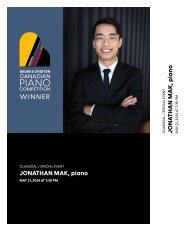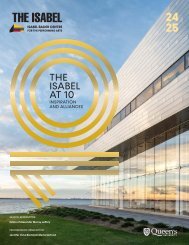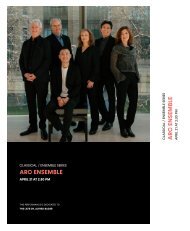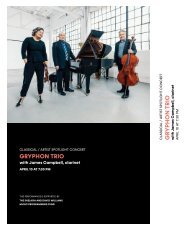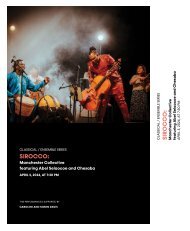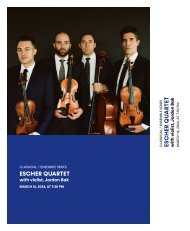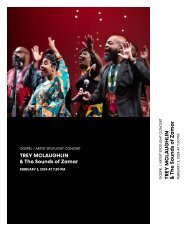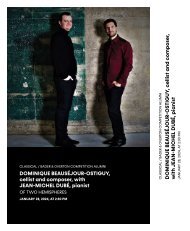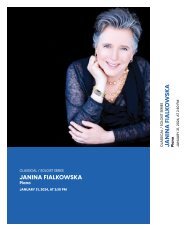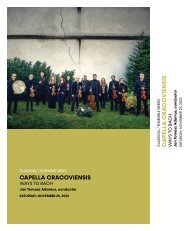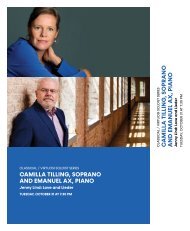Create successful ePaper yourself
Turn your PDF publications into a flip-book with our unique Google optimized e-Paper software.
CLASSICAL / SOLOIST SERIES<br />
TONY SIQI YUN<br />
Piano<br />
DECEMBER 1 AT 7:30 PM<br />
CLASSICAL / SOLOIST SERIES<br />
TONY SIQI YUN<br />
Piano<br />
DECEMBER 1 AT 7:30 PM
CLASSICAL / SOLOIST SERIES<br />
TONY SIQI YUN<br />
Piano<br />
DECEMBER 1 AT 7:30 PM<br />
PROGRAM<br />
BACH/BUSONI Herr Gott, nun schleuss den Himmel auf, BWV 617<br />
LISZT Bénédiction de Dieu dans la Solitude, S. 173/3<br />
BEETHOVEN<br />
Piano Sonata No. 21 in C Major, Op. 53, Waldstein<br />
Allegro con brio<br />
Introduzione: Adagio molto<br />
Rondo: Allegretto moderato – Presto<br />
INTERMISSION<br />
BERIO<br />
“Wasserklavier” from Six Encores<br />
BRAHMS Piano Sonata No. 3 in F Minor, Op. 5<br />
Allegro maestoso<br />
Andante espressivo<br />
Scherzo: Allegro energico<br />
Intermezzo: Andante molto<br />
Finale: Allegro moderato ma rubato
PROGRAM NOTES<br />
The admiration Ferruccio Busoni (1866-1924)<br />
felt for the music of J.S. Bach can be seen in the<br />
many solo piano transcriptions he made of Bach’s<br />
music. Originally composed for organ, the chorale<br />
prelude that opens this concert (Lord God, Now<br />
Open the Heavens), requires exquisite voicing<br />
and judicious use of pedal to convey the original’s<br />
walking bass line, running sixteenth notes, and<br />
elongated chorale melody. Melodic projection<br />
also lies at the heart of Bénédiction de Dieu dans<br />
la Solitude (The Blessing of God in Solitude) by<br />
Franz Liszt (1811-1886). One of a set of 10 pieces<br />
inspired by the poetry of Alphonse de Lamartine,<br />
the poem at the heart of this piece expresses the<br />
unexpected discovery of faith in God. The way<br />
Liszt constantly shifts the piano figuration to<br />
embrace the repeated melodic lines makes it easy<br />
to hear in the music’s spirituality, a foreshadowing<br />
of Liszt’s own religious conversion when he later<br />
received holy orders at the Vatican.<br />
Ludwig van Beethoven (1770-1827) wrote 32<br />
piano sonatas and it’s perhaps not surprising that<br />
many of the more popular ones have been given<br />
nicknames for identification, or are referred to<br />
by the sonata’s dedicatee, as is the case with the<br />
Opus 57 Sonata inscribed to Count Ferdinand<br />
von Waldstein. In addition to the enormous<br />
technical challenges Beethoven requires of the<br />
performer in this sonata, it is remarkable how<br />
many novel piano effects are employed that<br />
make this sonata so distinctive. Fine examples<br />
of this sonic originality include the way that the<br />
first movement’s opening theme in solid thirds,<br />
is almost immediately activated with broken<br />
tremolos, and the final movement’s octave<br />
glissandos in both hands in the coda.<br />
Italian composer, Luciano Berio (1925-2003),<br />
was known during his lifetime as a leader of<br />
the avant-garde, but would occasionally write<br />
expressive, short piano pieces. In 1990, he<br />
published some of these piano miniatures as,<br />
Six Encores, with “Wasserklavier” being the<br />
oldest piece, dating from 1965. Its title translates<br />
as “Water Piano,” and the fluidity of the tempo<br />
and rolled chords reflect this.<br />
Johannes Brahms (1833-1897), composed and<br />
performed the three piano sonatas he marked<br />
as Opus 1, Opus 2, and today’s towering Opus<br />
5, before he turned 21. He would never again<br />
write a piano sonata and Opus 5, with its fivemovement<br />
design of alternating fast-slow<br />
movements, is the most performed and recorded<br />
of the three. This sonata’s outer movements are<br />
dramatically conceived with an emphasis on<br />
motivic development often employing intensely<br />
chromatic harmonies as heard in the elaborate<br />
realization of the descending stepwise-moving<br />
bassline the opens the first movement. The lyrical<br />
music in these outer movements is often set<br />
apart with beautifully supportive accompaniment<br />
patterns. The central third movement is marked<br />
Scherzo but there is a Viennese waltz quality that<br />
makes the music dance. One of the reasons for<br />
this sonata’s popularity undoubtedly lies in how<br />
the main musical idea from the second movement<br />
is reworked in the fourth movement, which<br />
explains this movement’s subtitle, Rückblick<br />
(Retrospect). This moment of calm is balanced<br />
by the steady build-up in the final movement to a<br />
rapturous coda in F major that continually gains<br />
in velocity and bravura until the dramatic widely<br />
spaced chords at the movement’s conclusion.<br />
©<strong>2023</strong> by John Burge for the Isabel<br />
ABOUT TONY SIQI YUN<br />
“<strong>Tony</strong> is a true poet of the keyboard. Expressive,<br />
and with his own distinct voice, yet elegant and<br />
posied.” — Pianist Magazine<br />
The Canadian-born pianist <strong>Tony</strong> <strong>Siqi</strong> <strong>Yun</strong>, Gold<br />
Medalist at the First China International Music<br />
Competition (2019) and awarded the Rheingau<br />
Music Festival’s <strong>2023</strong> Lotto-Förderpreis, is quickly<br />
becoming a sought-after soloist and recitalist.<br />
During the 2022-23 season, he made his<br />
highly acclaimed subscription debut with the<br />
Philadelphia Orchestra under the baton of<br />
Yannick Nézet-Séguin, and this season, he joins<br />
Nézet-Séguin on a US Tour with Orchestre
Metropolitain, including an appearance at<br />
Carnegie Hall. Also in <strong>2023</strong>-24, he makes debut<br />
appearances at the Colorado Music Festival, the<br />
Aspen Festival, the Vail Dance Festival and with<br />
the Hamilton (ON) Philharmonic, conducted<br />
by Gemma New. Other engagements include<br />
Edmonton Symphony and Orchestra Lumos with<br />
Michael Stern, the Rhode Island Philharmonic<br />
with Joseph Young and the New Jersey<br />
Symphony. <strong>Tony</strong> has also appeared with the<br />
Cleveland Orchestra, Toronto Symphony, Buffalo<br />
Philharmonic, Orchestre de Chambre de Paris<br />
and Shanghai Symphony Orchestra.<br />
<strong>Tony</strong> regularly performs solo recitals in both<br />
Europe and North America. Recent and future<br />
highlights include his debuts at the Hamburg<br />
Elbphilharmonie, Gewandhaus Leipzig, Tonhalle<br />
Düsseldorf, Philharmonie Luxembourg and in<br />
North America at Stanford Live, Gilmore Rising<br />
Stars Series, and 92nd Street Y in New York, with<br />
a return visit to the Vancouver Recital Series.<br />
He is a recipient of the Jerome L. Greene<br />
Fellowship at the Juilliard School where he<br />
studies with Professors Yoheved Kaplinsky and<br />
Matti Raekallio. ●<br />
Give the gift of music<br />
this holiday season with an<br />
Isabel Gift Certificate<br />
in the amount of your choice.<br />
Janina<br />
Fialkowska,<br />
piano<br />
IN THE<br />
NEW<br />
YEAR<br />
MANCHESTER COLLECTIVE<br />
WITH ABEL SELAOCOE<br />
GRYPHON TRIO<br />
CLASSICAL / SOLOIST SERIES<br />
Sunday, Jan 21, 2024, 2:30 pm<br />
Praised for her musical<br />
integrity and refreshing<br />
natural approach, pianist<br />
Janina Fialkowska has<br />
been hailed as “one of<br />
the Grandes Dames of<br />
piano playing” (Franfurter<br />
Allgemeine). A venerated<br />
interpreter of the music<br />
of Chopin, she makes her<br />
long-awaited return to the<br />
Isabel, sharing the music<br />
that made her famous.<br />
SING AND SWING—<br />
A JAZZ AT LINCOLN CENTER<br />
PRESENTS PRODUCTION<br />
TICKETS:<br />
General Public $45+<br />
Faculty/Staff $41+<br />
Students $10+<br />
GIFT CARDS & TICKETS AVAILABLE AT: queensu.ca/theisabel · 613-533-2424





